


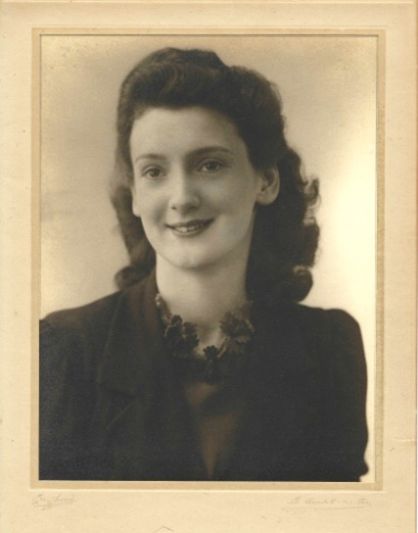
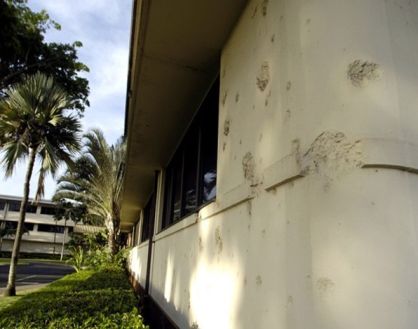
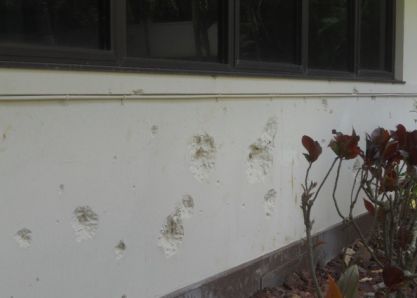
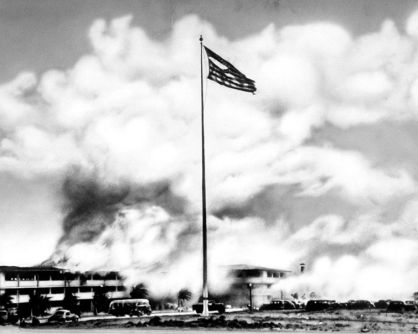
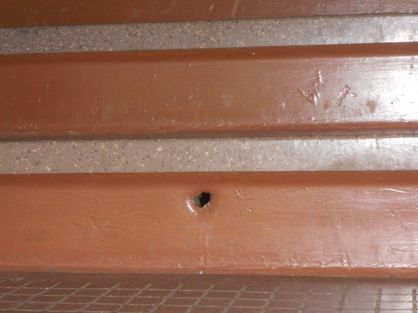
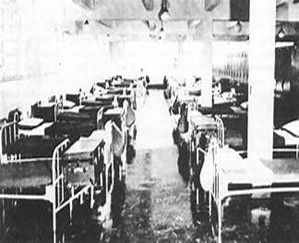
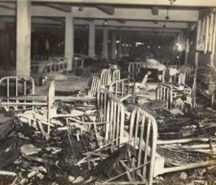
Albert C. McMullen
WWII Veteran
Pearl Harbor Survivor
This is the life account of Albert Charles McMullen, as known and written by his youngest daughter Lynn McMullen Brenton. Albert was born on September 15, 1922 in the small town of Monroe, Michigan. His parents were Merrill D. and Frances (Weiss) McMullen. He had 4 siblings two sisters, Sarah and Myrtle, and two brothers Edward and Jack.
He attended Monroe High School graduating in June of 1940 and joined the Army Air Corp shortly thereafter at the age of 17. He served as an administrative specialist and was assigned to Hickham Field as an instructor at the Hawaii Air Corps Technical School as a member of the 17th Air Base Group. The school was located in what was referred to as the Big Barracks also nicknamed Hickham Hotel. At the time, it was the largest barracks that the Army had ever built. It was the residence for 3200 men and had not only sleeping quarters, but fitness, mess hall, laundry, essential shopping, and training classrooms. Historians believe that its size is exactly why the Japanese targeted the building. They knew they could inflict a high number of casualties.
The intent of the Japanese was to destroy the Pacific Fleet. Six ships were in the harbor and four were destroyed. The USS Arizona was sunk and over 1000 men died in the submerged remains. The Pearl Harbor Memorial is built over this ship. It was a devastating attack on our Navy. Since the focus of the memorial is on the ships, the primary intentions of the Japanese, there is really little mentioned of the Army casualties and the destruction that occurred on base. I was fortunate to visit the memorial with a friend stationed on Hickham serving as an Air Force Major at the Pacific Command Headquarters. When I mentioned my Dad was at the barracks, he revealed that the building had been preserved and now served as his office space. The building is not open to the public. Not even the general military has access, as it now serves as the Pacific Command Headquarters. Only with proper escort, can you gain access. With my friend working there, I had that escort, and was given the rare opportunity to tour the building.
Albert would jokingly say he survived the Pearl Harbor Attack because of his modesty. He said they were awakened about 8 AM on Sunday December 7, 1941 to the sound of explosions. Everyone ran to see what was happening except him. He decided to first put on a pair of pants. The rest of the men ran out in their underwear and headed down the stairs to go outside. Just as they reached the stairs, the Japanese strafed the building, and they were all killed by gunfire. Al was only 15-20 seconds behind. Everyone in his platoon perished except him.
Touring the building put everything in perspective. My first impression was just the size, as I had no clue it housed so many. The building is not only preserved, but very well documented, with marquees describing it and memorabilia and pictures throughout. As we walked around the exterior, I could see the devastation from that attack. The roof had collapsed and had been replaced, but the concrete walls stood. However, they looked like they had measles. I was not prepared with a high quality camera but did take pictures showing the pock marks. They ranged in size from softball to the size of a small tire (pictures below). When we reached the front of the building, I was further shocked. The front had a pair of two large doors that opened out together. They led into the foyer of the building. As they opened, I faced a large (15-20 foot across) iron staircase full of holes from gunfire. I knew instantly that this was the staircase Al had talked about. It made perfect sense. There would have been men in front of his platoon and the big doors would have been wide open. Planes flying overhead would have a straight shot at the staircase. The holes were sizeable. My small camera made it impossible to get the staircase picture I wanted but I did capture a few treads to show the size of the holes. I was chilled. I walked up the steps, and at the top, thought about what Al must have seen as he approached.
My friend’s office space was at the top of the stairs, and there was documentation about his office in the hall in front of the room. It turns out the office had been the residence hall where the men slept. The marque had pictures of before and after the attack and I was able to obtain copies. I actually got to tour the room where Al put on his pants. Al also explained that the attack was in the middle of when breakfast was served. The cooks all ran into the freezer for protection. Unfortunately, the bombing resonated in the structure, and all of them died of concussions. He said survivors scrambled to the flight line directly behind the barracks. In what must have been chaos, they were given machine guns, and began firing at the incoming planes. He said no one knew who hit what. He said if there was one gun firing there was a hundred. I regret now that I didn’t ask questions. Where did they sleep that night? How did they prepare food for 3200 men with no cooks and a decimated kitchen? What did they do to clean up and put out the multiple fires? What a remarkable, unplanned and unexpected day my visit turned out to be.
Shortly after the attack, Al was relocated to Midway Island, a strategic location near Hawaii. As fortune (or misfortune) might have it, he was there on June 3rd 1942 and participated in the Battle of Midway. The U.S. Army Air Force launched attacks on the Japanese fleet from the island. The B-17E, Flying Fortress, was used to perform high-altitude bombing runs. These aircraft had tail gunners equipped with .50 caliber machine guns. Although Al never explained why, the administrative instructor found himself arming one of those guns. His short description of that experience – it was cramped and scary.
Soon after, Al was assigned as Glenn Miller’s booking agent. Glenn Miller was in England doing radio broadcasts and performing at various venues and bases across Europe. Al was arranging for Glenn Miller to perform at the Winter Gardens in Blackpool, England. The Winter Gardens Empress Ballroom, where my mother, Margaret Kirkham, was taking lessons, was where the performance was to be held.
Blackpool was an entertainment town. It was known for its seaside boardwalk with carnival atmosphere as well as its vivid nightlife with stage shows and operas. During the war, it was even more attractive. London was being blitzed and many people moved out and most entertainers headed to Blackpool. The RAF had commandeered the Winter Gardens for training during the day and then it was used to entertain in the evening. Many US soldiers were in the area also for training. Margaret lived in nearby St. Annes and took the train to Blackpool. She said the British girls didn’t like the American soldiers very much. They would hit on the women as they traveled on the train trying to get dates. She said they were cheeky and braggarts. They said they were there to “save” the British. This did not endear them to the girls, or the locals. As a result of this reputation, the Americans were not allowed to take ball room dance classes at the Winter Gardens. But Al was different. He wasn’t cheeky, nor a braggart. We know he was modest. In the process of arranging for the Glenn Miller event, he had become friends with the manager of the Winter Gardens and the lead dance instructor. When he asked if he could take lessons, they agreed. He was the only American on the dance floor. They danced in uniform so he would have stood out and drawn attention. He certainly got my mother’s attention.
A romance flourished, and they were married June 1, 1945. The war ended and Al was discharged as a tech sergeant and returned to Monroe, Michigan in September 1945. Margaret had to wait until the Army sent transport for the war brides. She arrived in February 1946 on the USS James Parker a troop transport ship.
In Monroe, Al found work as a production manager at the Coca-Cola and Stroh’s Distributorship. Later he worked at the Kaiser-Frazer plant in Ypsilanti and at Woodall Industries in Monroe. In 1951 however, he found his career as a first responder. He joined the Monroe Fire Department and retired 31 years later. He always worked a second job and was known for wallpapering, painting and hanging draperies. Margaret was a cosmetologist and opened her own shop, Queens Court, on Monroe Street. They raised three children, Carol McMullen Evans of Monroe, Kirk McMullen of Monroe, and Lynn McMullen Brenton of Mary Esther, Florida. Al was a lifelong member of the Monroe Post 1138 Veterans of Foreign Wars. He was also active in Monroe Lodge 884, Loyal Order of the Moose, and Monroe Lodge 1503, Benevolent and Protective Order of the Elks. He was also a member of the First United Methodist Church. He passed away June 21, 1991 and his ashes were placed at Roselawn Memorial Park’s Chapel Mausoleum in 2024.
Al was a man of few words. His family honored that persona with an epitaph that simply reads “Irreplaceable”.

Bucket List Dreams was founded by a disabled Veteran who observed that military service can often impact ones quality of life.